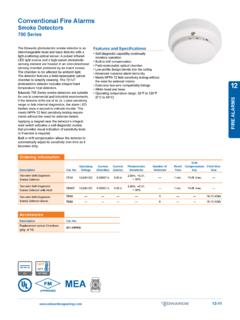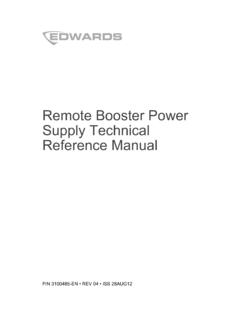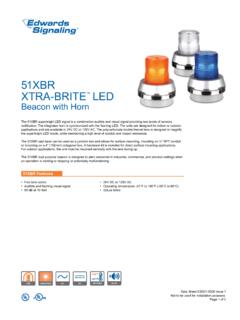Transcription of Fire Alarm FAQs - Edwards signals
1 5/2/2014 fire Alarm FAQsQuestionAnswerQ: How many zone/circuit fire Alarm panel do I need?A: The size of a fire Alarm panel is determined by a number of factors, including the size of the building, the number of devices, and the job's requirements. A zone is a defined area in a building in which related functional items work together. This could include things like Alarm annunciation (the panel will indicate what area of the building the Alarm occurred) and Alarm notification ( signals will only activate in particular areas of the building, not general Alarm ). On a conventional fire Alarm panel, the terms zone and circuit are often interchanged (one circuit could cover one zone). On an addressable panel, the zones are created in software (you can assign devices to zones). Circuits on a fire Alarm panel also have limits as to how many devices you can connect to them. The more devices, the larger the panel. It's also up to the engineer designing the system as to how he wants to divide up the building.
2 A single zone conventional panel, for example, may be able to support enough devices to cover a given building, but you would be limited in terms of annunciation at the panel because you won't be able to tell where in the building the Alarm came : What candela strobes do I need?A: The brightness requirements (candela) of a strobe is determined by where it is being installed. The larger the room, the brighter the strobe. NFPA 72 National fire Alarm Code sets the standards for this and provides a chart with different room sizes along with the strobe requirements for each. If an area needs multiple strobes, those strobes must also be synchronized with each other (flash at the same time). See also "How can I synchronize the strobes on the fire Alarm ".Q: What do I need for elevator recall?A: ANSI is the national elevator code, but local codes may be different. You should always refer to the proper codes for your area for exact requirements. Typically you will need the following: a smoke detector located in each elevator lobby; a smoke and/or heat detector in the elevator machine room (the heat if there are sprinklers); a heat detector located at the top of the elevator shaft (if there is a sprinkler at the top); a smoke detector located at the top of shaft (if there is a sprinkler anywhere in the hoist way); a set of relays located in the elevator machine room to control the elevators (primary, alternate, shunt); a visual warning ("firefighter's hat") indicating if elevators are unsafe to use; and a control panel (the panel can be the building's fire Alarm panel or a dedicated panel if there is no FA panel).
3 Q: How many signals can I connect to the fire Alarm panel's NAC (Notification Appliance Circuit)?A: The number of devices you can connect to a signal circuit (NAC) is based on the current rating of the circuit and the current rating of the devices connected to the circuit. You must add up the current draw of all the devices and make sure the total does not exceed the rating of the circuit you want to connect them to (it's also a good idea not to exceed 80% of the circuit's rating to give some margin for error and/or room for expansion). To find the current draw for a particular device, you should refer to the device's installation sheet or the device's product label. A fire Alarm device will have a FWR (Full Wave Rectified) and DC current draw rating. Be sure to use the correct current based on the type of power supply. Also be aware that multi-candela strobe devices will have a different current rating for the different candela settings (the higher the candela, the more current).
4 Use the current rating for the candela you are setting the strobe to (some jurisdictions, however, require you to use the worst case value, regardless of how bright the strobe is set; check with your local AHJ). Q: How far can I run the signal circuit (NAC) wire on my fire Alarm panel?A: You must do a voltage drop calculation for each circuit. The method for doing this should be included with the manual that comes with the fire Alarm panel or booster power supply. You will need to know the following information to do the calculation: 1) The minimum operating voltage of the signaling device (for a UL regulated 24 volt device, this would be 16 volts). 2) The maximum operating current of each device (and therefore the total current draw of all devices connected to the circuit). 3) The minimum circuit voltage rating of the NAC (typically 85% of nominal 24v or volts, but refer to panel's manual for correct value). 4) The resistance of the wire used for the signal circuit.
5 Q: How far can I run the IDC (Initiating Device Circuit) wire on my fire Alarm panel?A: Panel installation manuals should include this information (it is not the same for all panels). Typically it is based on the circuit's maximum allowable : How far can I run my addressable loop wire?A: The distance you can run the wire on an addressable loop is determined by the size and type of wire used and the number of devices. You should refer to the fire Alarm panel's manual for this : How loud do my signals need to be?A: NFPA 72 National fire Alarm Code sets the standards for what's required. For public mode, signals must produce a sound level of at least 15dB above the average ambient sound level or 5dB above the maximum sound level having a duration of at least 60 seconds, whichever is greater, measured at 5 feet above the floor throughout the covered : What size batteries does the fire Alarm panel need?A: fire Alarm systems must have a secondary means of power in case of AC power failure.
6 Battery calculations will determine what size batteries are needed, and should be included with the panel or booster power supply manual. You will need to know the following information to do the calculation: 1) The required standby time (typically 24 hours). 2) The required Alarm time (typically 5 minutes). 3) The panel's total supervisory current draw. 4) The panel's total Alarm current draw (including signal load).Q: What type of device should I install in a kitchen, a smoke detector or heat detector?A: It is generally recommended that fixed temperature heat detectors be installed in kitchens. Every day cooking activities can cause smoke detectors to Alarm , and rate of rise type heat detectors can be set off by the sudden temperature increase due to an oven door opening. If the ambient temperature in the kitchen does not exceed 100 degrees F, then you can use a 135F detector. Otherwise you would have to use one with a higher temperature rating (like 194F).
7 Q: What is the difference between class B and class A wiring?A: In general, class B wiring is a pair of wires from a fire Alarm panel circuit that's wired plus and minus, in and out of each device (in parallel), with an end of line resistor wired across the plus and minus of the last device (note: an addressable circuit, SLC, would not have an EOL resistor). Class A circuits wires to the devices in the same way, except that instead of an end of line resistor after the last device, the wires are returned back to another set of terminals at the fire Alarm panel. With class B wiring, if there is a break in the circuit, every device after the break will stop working. With class A wiring, power/communications to the devices is fed from 2 directions, so if there is a single break in the wire, all the devices will continue to : How do I test my smoke detectors?A: You should always follow the manufacturer's instructions provided with the device. In general, a functional test of a smoke detector can be done by using a can of aerosol smoke recommended by the manufacturer.
8 For Edwards Signaling smokes, the can is sold under part number P-047546-0025. Some detectors have a mechanical means of testing (ie: magnet test), such as the Edwards 500 and 700 series devices, but this does not substitute for a functional test using smoke. In addition to a functional test, a calibration test must be done to check the sensitivity of the detector. Depending on the device, this may require an external meter or other measuring device. For the Edwards Signaling 500 and 700 series smokes, you can use a magnet, which will give you feed back via the detector's LED (number of flashes). For the addressable E- series, sensitivity can be checked from the fire Alarm panel. NFPA 72 National fire Alarm Code sets the standard for how often smoke detectors are : How do I test my heat detectors?A: You should always follow the manufacturer's instructions provided with the device. In general, if it is rate of rise type heat detector, you can use a hair dryer or heat gun to warm the body of the device.
9 If it is a combination rate of rise with a non-self restoring fixed temperature element, you can test the rate of rise portion, but you must protect the fixed temperature element from the heat by covering it with something. If it is a non-self restoring fixed temperature only heat detector, you cannot test it. NFPA 72 National fire Alarm Code sets the standard for how often devices must be tested. Non restoring fixed temperature heat detectors must be replaced after 15 years, or have 2 detectors per 100 be laboratory : What is the maximum signal load that can be connected to a signal circuit (NAC) on a fire Alarm panel?A: Each NAC (Notification Appliance Circuit) in a fire Alarm panel or booster power supply has a maximum current rating. This information can be found in the manuals provided with the panels. The total current draw for all the devices connected to the circuit cannot exceed the NAC rating. Be aware that the NAC current rating is different than the panel's power supply rating.
10 For example: A panel may have a power supply rating of amps, and include two NACs rated for amps each. You cannot put 2 amps of signal load on both NACs, however, because it will exceed the panel's total signal power of amps. See also "How many signals can I connect to the fire Alarm panel's NAC".Q: Does the addressable loop wiring have to use twisted/shielded wire?A: You should always follow the manufacturer's recommendation for wire type. The Edwards Signaling E-FSA addressable panels do not require twisted and/or shielded : How can I synchronize the strobes on the fire Alarm system so they flash at the same time?A: When using the Edwards FireShield, E-FSC, E-FSA fire Alarm panels, or the EBPS()A booster power supplies in conjunction with the Edwards Genesis series of strobe devices, strobe synchronization is built into each circuit (when configured for Genesis mode). By using Edwards panels and signals , you can synchronize all strobes across all circuits.



